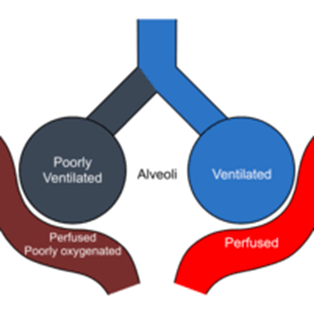A nurse is caring for a client who has respiratory failure due to ventilation-perfusion (V/Q) mismatch. The nurse should recognize that the client most likely has which of the following conditions?
Flail chest
Emphysema
Congestive heart failure
Guillain-Barré syndrome
None
None
The Correct Answer is B
Choice A Reason:
Flail chest is incorrect. Flail chest is a condition characterized by multiple rib fractures, causing instability in the chest wall. While it can lead to respiratory distress, it doesn't directly cause ventilation-perfusion (V/Q) mismatch. Instead, it impairs the mechanics of breathing by compromising chest wall integrity.
Choice B Reason:
Emphysema is a chronic obstructive pulmonary disease (COPD) where the alveolar walls are destroyed, leading to a loss of surface area for gas exchange. This results in areas of the lungs that are well-perfused but poorly ventilated, causing a V/Q mismatch. The damage to alveoli leads to impaired ventilation, while blood flow may still be adequate, leading to hypoxemia (low oxygen levels in the blood).
Choice C Reason:
CHF primarily affects the heart’s ability to pump blood effectively, leading to pulmonary congestion and impaired gas exchange. However, it typically causes diffusion defects rather than a direct ventilation-perfusion mismatch. V/Q mismatch may occur secondary to pulmonary edema, but it’s not the primary mechanism of respiratory failure in CHF.
Choice D Reason:
Guillain-Barré syndrome is incorrect. Guillain-Barré syndrome (GBS) is a neurological disorder that affects the peripheral nervous system, leading to muscle weakness and paralysis. While respiratory muscle weakness can occur in GBS, it doesn't directly cause ventilation-perfusion (V/Q) mismatch. GBS primarily affects nerve function rather than lung function.

Nursing Test Bank
Naxlex Comprehensive Predictor Exams
Related Questions
Correct Answer is D
Explanation
"If you have a cerebral aneurysm, you would be having seizures. “is incorrect because not all cerebral aneurysms cause seizures. Seizures may occur if the aneurysm ruptures and causes bleeding into the brain, but they are not a universal symptom of an unruptured cerebral aneurysm.
Choice B Reason:
"If you have a cerebral aneurysm, you will experience nausea and vomiting. “is incorrect because while headaches, nausea, and vomiting can occur with a ruptured cerebral aneurysm (subarachnoid hemorrhage), they are not necessarily present in all cases, especially with unruptured aneurysms.
Choice C Reason:
"If you had a cerebral aneurysm, you would have a stiff neck." is incorrect because a stiff neck (meningeal irritation) is typically associated with subarachnoid hemorrhage from a ruptured cerebral aneurysm, but it is not always present and is not a definitive symptom of an unruptured aneurysm.
Choice D Reason:
"If you have a cerebral aneurysm, you typically will have no symptoms." Cerebral aneurysms can vary greatly in terms of their presentation and symptoms. While some aneurysms may cause symptoms such as headaches, nausea, vomiting, seizures, or a stiff neck, many cerebral aneurysms are asymptomatic and go unnoticed until they rupture or are incidentally discovered during imaging studies for other reasons.
Correct Answer is C
Explanation
Choice A Reason:
Previous stroke is not directly associated with an increased risk of status asthmaticus. While individuals with certain medical conditions, such as neurological disorders, may have an increased risk of complications from severe asthma exacerbations, a previous stroke alone is not a recognized risk factor for status asthmaticus.
Choice B Reason:
Irritants and hypersensitivity to medications, may trigger asthma exacerbations, but they are not specific risk factors for status asthmaticus. Asthma exacerbations triggered by irritants or medications can typically be managed with appropriate treatment measures and do not necessarily lead to status asthmaticus.
Choice C Reason:
Previous intubation due to status asthmaticus episode is correct. Status asthmaticus is a severe and life-threatening asthma exacerbation that is unresponsive to standard treatment measures such as bronchodilators and corticosteroids. It is characterized by prolonged and severe bronchospasm, airway inflammation, and respiratory distress.
Choice D Reason:
Bronchial pneumonia is not a known risk factor for status asthmaticus. Bronchial pneumonia, or pneumonia affecting the bronchi and lungs, is a separate respiratory condition caused by bacterial, viral, or fungal infections. While pneumonia can exacerbate asthma symptoms in individuals with asthma, it is not specifically associated with an increased risk of status asthmaticus.
Whether you are a student looking to ace your exams or a practicing nurse seeking to enhance your expertise , our nursing education contents will empower you with the confidence and competence to make a difference in the lives of patients and become a respected leader in the healthcare field.
Visit Naxlex, invest in your future and unlock endless possibilities with our unparalleled nursing education contents today
Report Wrong Answer on the Current Question
Do you disagree with the answer? If yes, what is your expected answer? Explain.
Kindly be descriptive with the issue you are facing.
